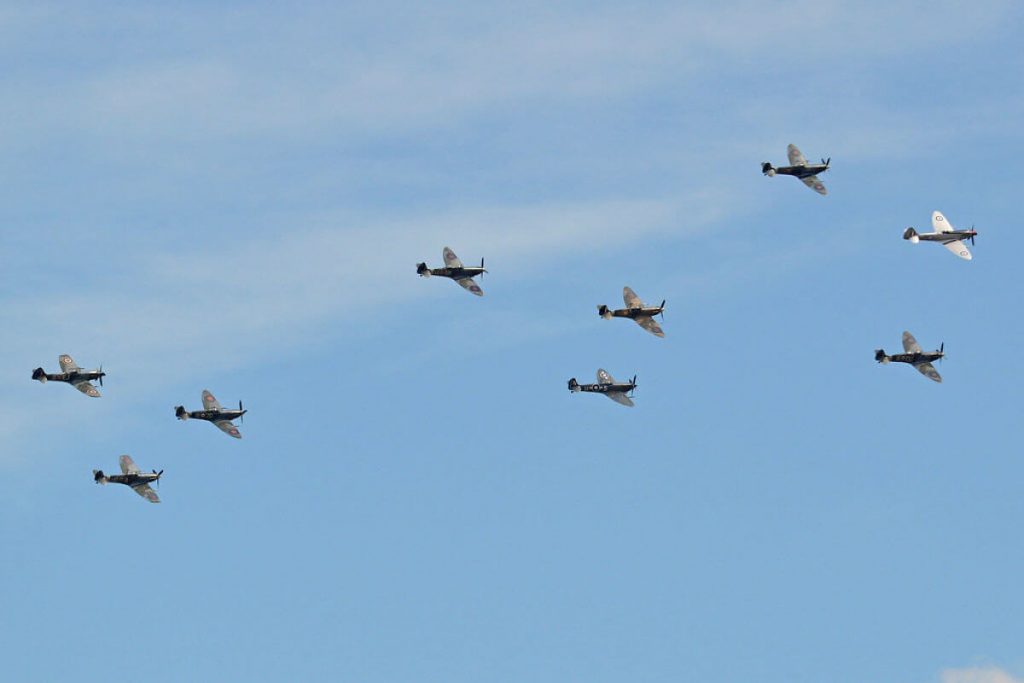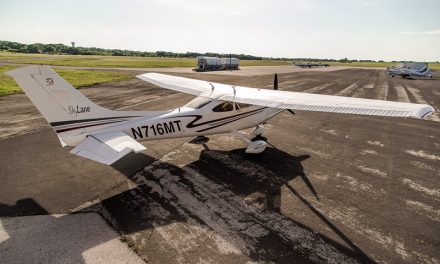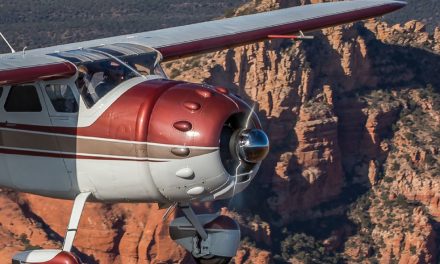Formation flight needn’t be terrifying or dangerous, provided you stay loose

Photo by Alan Wilson
The assignment was simple — fly over to Lubbock, Texas, spend 3 days with the U.S. Air Force basic training squadron at Reese Air Force Base, fly the Cessna T-37 Tweet and the supersonic North American T-38 Talon and write a story on how the USAF trains pilots.
In fact, most of the assignment was easy. The T-38 ride came at the end of the third day, and that was obviously the highlight of the trip. I’d recently completed an article on the F-15 Eagle at Nellis AFB in Nevada, and the Air Force had been pleased with the result, so they authorized two instructors in a pair of T-38s to fly on my pseudo training mission. Your tax dollars at work.
Tail chasing
About halfway through our T-38 flight, I asked if we could do a little tail chasing, and the two instructors eagerly agreed. At the time, I’d flown about 200 air-to-air sessions for this and other magazines, and I deluded myself into thinking I was pretty good at it. Of course, my airplanes had all been general aviation singles, twins, and turboprops — nothing
in the performance class of the T-38, affectionately known as the Little White Rocket. Photo formation relies on stable position and smooth air — no quick maneuvering allowed. I knew ACM (air combat maneuvering) in the T-38 would be far more aggressive. It was.
Watch the roll rate — if you can see it
I fell back into lead’s 7 o’clock position, roughly 30 feet left and behind, and my pilot counted down from five to zero. I thought I was ready for an extreme maneuver, but I wasn’t even remotely prepared for what came next. At the count of zero, the leader rolled hard right so fast he seemed to practically disappear before I had a chance to even move the stick. I could almost hear my pilot smiling into his oxygen mask, “We do things a little quicker here at Reese,” he said.
The lead pilot later told me he’d pulled about 7g in the turn-away, which is the limit on the T-38. We made individual landings and I found out exactly how large the pattern becomes when the approach speed is 165 knots.
Slow is the rule
Fortunately, general aviation formation flying is considerably less demanding. In fact, forming up in a loose flight of two is extremely easy if you follow a few simple rules. There are a few flight schools around the U.S. that teach formation flying but, by definition, they’re fairly expensive. Learning the skill demands a minimum of two airplanes of comparable performance.
For those learning formation on their own, don’t worry about the legality of your first formation attempt as long as the weather is appropriate, the airspace is clear, both airplanes are in good shape, and the pilots are in agreement as to who will do what and when. Good two-way radio contact is mandatory for beginning formation flyers. Don’t even think about launching a formation flight without good radio contact so everyone knows what’s coming next.
High-wing vs. low-wing
High-wing vs. low-wing isn’t normally a major problem, though its always best if the high-wing airplane flies lead since the wingman will be below them. If a high-wing must fly on a low-wing leader, they’ll want to maintain a slightly higher station to let lead keep them in sight. Once again, when both pilots become proficient at formation, lead won’t be looking back at their wingman.
Avoid the sun
Ideally, launch your flight as close to the middle of the day as possible, so the light source will be high, and no one will have the sun in their eyes. Photo formation sometimes demands a low sun, but it’s not necessary for practice formation flights.
Flying sequential takeoffs
Regardless of whether you’re departing a controlled airport or an uncontrolled runway, try to keep the leader in sight during the departure and climb out. If you’re flying from a controlled airport with a tower, ask the controller for a sequential release so the wingman can depart directly behind the leader without any aircraft in between.
No matter how good you think you are, formation takeoffs aren’t a good idea unless you have military experience (in which case, you probably won’t need to read this article anyway.) The question becomes academic at many controlled airports, as local authorities often forbid any form of formation departure.
You may have to wait a few minutes for a hole in traffic that will allow release of two aircraft, but it’s worth it to avoid having to poke around looking for each other in the sky. Keep the leader in sight at all times, but if for some reason you do lose visual contact, agree to meet over a given checkpoint at a specified altitude.
Speed control
Lead will always reach altitude first, so they should plan to reduce power to perhaps 45% or less to help the wingman catch up. If you’re flying wing and aren’t catching lead, ask them to make a few standard rate S-turns, always returning to the primary heading. This will allow you to turn inside their arc and catch up quicker.
Don’t consider any plan that suggests, “Let’s meet over the VOR at 4:30 at 5,500 feet.” A VOR, NDB, or other navaid is the worst possible place to meet. Cross-country traffic may be using that checkpoint for transition through the airspace, and that’s no place to be looking for your formation buddy.
Conversely, be aware that it’s a very big sky, and you may be surprised how difficult it can be to spot another airplane at “5,500 feet circling over the big, red barn.”
Flying the form-up
Don’t be in a hurry on the form-up, though. The join will depend partially on the drag profile of the wingman’s airplane. I once flew a TV air-to-air session in a Bellanca Super Decathlon, flying rolls, loops, and hammerheads, then rejoining for some closeups. The Super was a wonderful aerobatic trainer, but its drag profile was extremely high. I found I could fly forward to nearly a line abreast position, chop throttle, and practically match the camera ship’s speed in place.
Normally, however, be advised that what looks like a fairly slow overtake from a mile back suddenly becomes very quick when you’re only 100 yards behind. Better to take your time and ease into position, rather than expect to fly up and stop in place. If you’re having trouble catching lead, ask them to throttle back a little. Graduate your rate of overtake, so you can slip into position easily.
How close is too close
You’ll discover later in formation flying that it’s sometimes easier to fly a precise position in close than farther out, but plan to start off at least five single wingspans away from the leader. On most general aviation aircraft with spans of 30-40 feet, you should consider stepping into position 100 feet out. That’s plenty close for your first experience.
It’s important that the airplanes be evenly matched in performance. Given no other choice, I once flew an air-to-air photo session in a Citation, flying on a Skyhawk photoship over Sedona, Arizona, and that was probably the least fun I’ve had on an airplane in the last 50 years. Mooneys, Bonanzas, Comanches, Malibus, Centurions, and other models in the 150-170 knot class do well with each other. Similarly, Skyhawks, Cardinals, Warriors, Archers, Tigers, and similar 110-125 knot types also are usually harmonious.
Speed and altitude control
You’ll make the task more comfortable if the lead airplane flies a target indicated airspeed 15-20 knots below max cruise, perhaps 130 knots for retractables and 110 knots for slower, fixed-gear models. This isn’t a race, and those speeds should guarantee good control response and good overtake with reasonable stability.
Altitude is pretty much your choice, but smooth air and uncongested airspace are the ideal. It’s important to stay as far from other traffic as possible, as formation flights always seems to attract lookie-loos who’ll sometimes want to join in the fun.
Down and to the left
For most general aviation airplanes with side-by-side seating and the pilot on the left, the most comfortable formation is left echelon with the wingman stepped back and slightly down for easier visibility. Two other common formations are line abreast (side by side) and line astern (nose to tail). The latter two are slightly more difficult to fly, so stick to echelon in the beginning; there’s no wake to worry about as there may be with line astern.
The usual rule in a two-plane formation is that lead looks for traffic and advises their playmate of any possible conflict while the wingman concentrates on simply holding the desired formation position.
In other words, perhaps contrary to what some folks believe, the leader has major responsibilities during formation flight. They’re charged with finding smooth air (if possible), making any maneuvers slow and gentle with plenty of warning to the wingman, looking for traffic, and keeping speed at a reasonable number. Any climb or descent also needs to be slow and deliberate.
Leisurely maneuvering
The whole idea is to keep any maneuvers as unhurried as possible. If you haven’t flown formation before, merely holding a straight and level station will be challenging enough.
Since most general aviation airplanes seat the pilot on the left, the wingman should probably form up on the left side of lead so the pilots can keep an eye on one another. Later, when everyone is comfortable with standard formation, the leader should be able to concentrate on flying their position and not having to monitor the wingman. (That’s one reason most military fighter aircraft seat their two-man flight crews in tandem rather than side by side. A fighter pilot flying wing can fly left or right echelon with few restrictions to visibility.)
Announce before doing
Lead can make everyone’s job easier by announcing well in advance what they plan to do so wing can prepare for the maneuver. During photo formation, we use the 5-second rule. If lead wants to turn left or right to a new heading for a better sun line, they should announce, “Turning left in five seconds,” and release the mic button.
If lead insists on counting over the radio, the wingman has no opportunity to reply and say, “No turn” if they’re out of position. Even a gently banked heading change will cause the inside airplane to fly a tighter circle at a slightly reduced speed, so if the wingman is flying slightly out of position, more in line abreast, they’ll have more trouble adapting to a left turn. Conversely, if they’re flying farther aft, and the turn goes away from them, they’ll have to work harder and use more power to catch up.
Holding position
Don’t be afraid to apply whatever throttle is necessary to hold position. If you have speed brakes, by all means use them to help you decelerate when you’re too fast. I once flew with the Royal Canadian Air Force Snowbirds in their little, two-seat, side-by-side Canadair Tudors, and the airplanes’ large speed brakes, mounted on both sides of the aft fuselage, had been modified to deflect fully in about one second. With nine airplanes in the full formation, the Snowbird pilots were experts at rejoins, and their ability to tuck all nine Tudors into tight formation was a joy to behold.
Trading lead
If you agree in advance, you can trade lead back and forth by flying out wide at the same altitude and powering past the lead as soon as he says he has you in sight. When you’ve assumed lead, you should announce, “I have the lead,” and it’s your playmate’s turn to fly on you.
Just remember the cardinal rule of formation flight; the wingman always keeps their leader in sight. If wing loses the leader, they should announce, roll away in a safe direction and start the process all over. Formation flying isn’t that difficult if you keep it loose and both pilots are on the same page.





